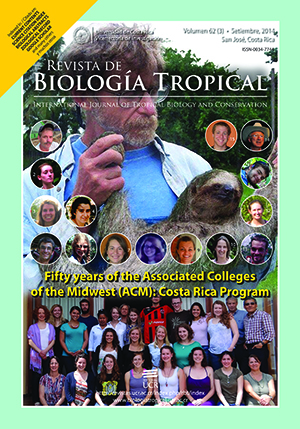Abstract
Phlegmariurus is the only genus of Lycopodiaceae with the species grouped in 22 informal groups. Species level relationships within Phlegmariurus are poorly understood and their circumscriptions require a thorough molecular and morphological review. A detailed study of morphology and anatomy of caulinar axes, lycophylls and sporangia of Phlegmariurus phylicifolius was carried out in order to contribute to the elucidation of species circumscription in the informal group Phlegmariurus phlegmaria. Small pieces of caulinar axes bearing trophophylls, sporophylls and sporangia were fixed, dehydrated, Histowax (paraffin) embedded, sectioned in a rotatory microtome, and stained using the common Safranin O-Fast Green technique; handmade cross sections were also made and stained with the same technique. P. phylicifolius includes slender, pendulous plants up to 40cm long. Shoots heterophyllous, in the basal divisions ca. 10-20(-25)mm in diameter including the trophophylls, then abruptly constricted to (l-) 1.5-2(-2.5)mm in diameter including the imbricate, reduced sporophylls. Trophophylls are borne in alternating whorls of three, or decussate, subdecussate, or alternate, widely spaced in alternate leaved caulinar axes portions, perpendicular to the caulinar axes to falcately ascending, lanceolate to linear-lanceolate, with flat to slightly revolute margins. Each lycophyll is supplied by a single central vascular bundle, connected to a protoxylem pole in the stele. At the site of leaf-trace departure, no leaf (lycophyll) gap is present. Caulinar axes excluding leaves 0.7-1.2mm thick at the base, upward tapering to ca. 0.5mm. Caulinar axes present unistratified epidermis and endodermis, the cortex is characterized by the presence of a trabecular structure of lisigenous origin formed in the parenchimatous tissue next to the endodermis. The vascular tissue occupies the central part of the caulinar axes, forming a plectostele of subradiate organization, with five poles of protoxylem. The epidermal cells present sinuous anticlinal walls; invaginations in the inner side of external periclinal wall of the epidermal cells could be probably adaptive morphological feature of a water deficient environment. Leaves of constricted terminal divisions are decussate, or subdecussate, continuously or discontinuously sporangiate, appressed, abaxially rounded to carinate, widely lanceolate to widely ovate or subcordate, acute to mucronate or cuspidate, shorter than the sporangia. Each sporangium originates from a group of epidermal cells, axilar to the sporophylls. The cell walls of epidermal cell of the sporangia are Huperzioideae type. The morphological studies of trophophylls contribute to confirm the differences between P. phylicifolius and P. subulatus.
##plugins.facebook.comentarios##

This work is licensed under a Creative Commons Attribution 4.0 International License.
Copyright (c) 2014 Revista de Biología Tropical






